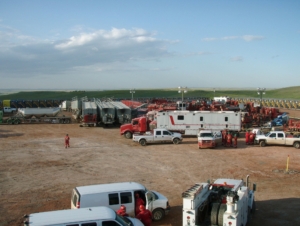Work Less, Study More, and Forget About GDP
by Gregory M. Mikkelson
Trends in human health have recently decoupled from GDP growth throughout the world. In other words, health improvement no longer tracks economic expansion. Meanwhile, environmental degradation remains firmly coupled to economic growth. As damages from economic growth mount globally, and as benefits fade, the case against further growth is stronger every day.
Within the USA, the case against economic growth is especially compelling, and not just because of the country’s massively disproportionate contribution to global ecological breakdown. I present evidence below that among U.S. states, growth in GDP (a.k.a. “gross state product”) per capita actually hinders educational attainment, worsens health outcomes, and degrades environmental quality. In other words, education, health, and environment are all tied negatively to economic growth.

Working less leaves more time to exercise and enjoy nature. (Staticflickr.com)
This evidence stands in absolute contradiction to mainstream dogma, according to which economic growth is necessary for progress in education and health. Instead, as an alternative to GDP growth—rather than a supposed corollary of it—state-level progress in education seems to boost human health and enhance environmental quality.
In this essay, I first canvass recent (21st-century) state-level trends in education, health, and environment. Then I report on how growth in GDP per capita relates to those trends, and reflect a bit on why. Finally, I report on how progress in education relates to health and environment. The specific examples of North Dakota and New Jersey help to illustrate the general patterns revealed through statistical analysis.
Recent Socio-Ecological Trends among U.S. States
Despite half a century—or actually a century and a half—of social and ecological critiques of economic growth, growth-obsessed governments have abetted a six-fold explosion of the U.S. economy over the past 60 years. This includes a near-doubling of population, and a more-than-tripling of real GDP per capita.
In the 21st century, statistical agencies have collected and published state-level data on two key aspects of life that growth supposedly makes better, namely education and health. They have also gathered figures concerning one of the many problems made worse by growth, carbon dioxide pollution. Let’s consider each trend in turn, noting that they unfold in the context of growing GDP per capita.

Richer and dumber since 2013. (NAEP)
To track educational performance, I use eighth-grade reading and math scores because state laws require residents to attend school only up to that level. This composite metric of educational performance took a turn for the worse in the five largest U.S. states, home to nearly two fifths of the U.S. population, even before COVID-19 severely disrupted public education.[i] In most other states as well, and in the country as a whole, eighth-grade reading and math scores declined between 2013 and 2022.
Health has also taken a hit. In every state and in the country as a whole, healthy life expectancy declined between 2013 and 2019. Healthy life expectancy takes into account not only average longevity but also prevalence and severity of disease. Although the data are not yet available for years after 2019, the pandemic undoubtedly reduced healthy life expectancy still more.[ii] Meanwhile, carbon dioxide emissions have declined somewhat in most states. But as we shall see, GDP growth has impeded (and in many cases reversed) that modest improvement.
Economic Growth vs. Education, Health, and the Environment
Statistical analysis (regression modeling) shows that across the entire period for which we have data (2003-2019), the richer states get, the worse they do in terms of education, health, and the environment. Reading and math scores decline by an average of 0.24 percent for each percent of growth in GDP per capita. Healthy life expectancy also declines with economic growth, although by a mere 0.016 percent for each percent increase in GDP per capita. Meanwhile, emissions increase by an average of 0.61 percent for each percent of growth in GDP per capita, which is consistent with previous findings that environmental impacts such as biodiversity loss track state-level economic growth.
To illustrate the point, consider the extreme high end of our sample in terms of economic growth. North Dakota’s fracked-oil boom helped make it the fastest-growing state so far in the 21st century. GDP more than doubled there from 2003 to 2019, with GDP per capita surging by 66 percent. Over those same 16 years, average North Dakotan reading scores, math scores, and healthy life expectancy all declined, while carbon dioxide emissions jumped by 11 percent.

Fracking for growth comes at the expense of education, health, and the environment. (Wikipedia)
What could explain the evident conflict in U.S. states between GDP growth, on one hand, and education and health, on the other? Stepping back for a moment, let us note that individuals often face short-term tradeoffs between making money and gaining knowledge, as in getting a job vs. going to school. We might speculate that longer working hours leave parents with less time to help their kids with homework. Parents may feel pressure to take on extra work in a booming economy, while jobs are plentiful. They could be hard-pressed to meet all their family needs in a two-income household.
As for health, one researcher has pointed out that people tend to not only work more, but also drive more, drink more, and exercise less, during economic booms—all of which have negative health consequences. Each of these behaviors might be expected to increase if people take on more work than is good for them and their families.
For larger scales and longer terms, I suspect that the growth-wellbeing tradeoff is a matter of prioritization. When state governments and the societies they represent prioritize GDP growth, it not only fails to benefit education and health, it actually hinders them—on top of despoiling the environment.
Progress in Education = Advances in Health and Environment
So what happens when governments get their priorities straight, turning away from GDP growth and focusing instead on directly promoting education, health, environment, and other genuinely important concerns? Additional analyses indicate that progress in education—which, as shown above, appears to suffer rather than benefit from GDP growth—translates into progress in health and environment as well.
Years of schooling has a positive relationship to healthy life expectancy among countries around the world. I find that health also tracks educational attainment, measured in terms of eighth-grade reading and math scores, among states in the USA. Moreover, carbon pollution declines with that same state-level measure of educational success. For each one percent of improvement in reading and math scores, healthy life expectancy goes up by an average of 0.039 percent, and carbon dioxide emissions go down by an average of 0.25 percent.

Education for a flourishing steady state. (Wikipedia)
To illustrate this general point, consider a specific case near the high end of our sample in terms of educational improvement. In 2019, New Jersey eighth-graders outscored their 2003 predecessors by two points in reading, and 11 points in math (both on a 300-point scale). By 2019, New Jersey residents could expect over six months more of healthy life than they could in 2003. And they collectively emitted 23 million fewer tons of carbon dioxide than they had 16 years before. Meanwhile, New Jersey’s GDP grew by less than eight tenths of one percent per year—still too much, from a steady-state perspective, but more slowly than 44 out of 49 other states over the same period.
We’ve long known about the fundamental conflict between economic growth and environmental protection. As nations responded to the COVID-19 pandemic, they faced another conflict, between economic growth and public health. The current analysis suggests that in the USA, growth conflicts not only with the environment, and not only with health, but also with education. In contrast, educational progress seems to boost health and relieve pressure on the environment.
[i] Raw U.S. life expectancy, for which data are available, declined by nearly two years from 2019 to 2020, and by more than half a year from 2020 to 2021.
[ii] For the graph and regression analysis, I re-scaled reading and math scores each to a mean of zero and standard deviation of one, then added them together, and re-scaled their sum to a mean of 100 and a standard deviation of 15, as in IQ.
Greg Mikkelson is CASSE’s Ecological Economist.








Sound arguments, I agree. I would add that greater emphasis on education also fits the steady state mantra of “don’t grow the economy, develop it.” Ideally we’d see the volume of resources consumed, and wastes emitted, remain stable and sustainable, while the degree of knowledge and skill that is applied to those inputs/outputs keeps increasing for a long time.
Education is important. “The more you know, the less you blow….your money on garbage”.
Education also allows people to be happier with fewer children as their life reach is to do things either for others, for themselves or just living without having to spend 2-3 decades raising more kids than you can afford or manage. As the trend of this goes to 3rd world countries, their population growth rate slows.
One of the drivers of GDP is sprawl, which requires more cement, more extensive infrastructure, more driving, bigger cars, and thus less purposeful exercise. The growth economy is not helped when people walk to the food market, but oil and automobile industries benefit, in GDP, when people need to get into an SUV in order to go buy a loaf of bread. Sprawling Atlanta produces more than 500 annual traffic deaths while compact Barcelona (exact same population as Atlanta) has fewer than 30 annual traffic deaths. Greg is right. GDP worsens health outcomes.
I sure want to believe this article, but let me play devil’s advocate.
First, is there any evidence to support or contradict a claim that the states with higher education attainment may be “off-shoring” their emissions to states with less? For example, cap gains are not counted in GDP, but according to https://www.empower.com/the-currency/money/what-is-the-average-net-worth-by-state, NJ ranks 4th in average net worth. High net worth correlates with financial investment, which may yield cap gains. Financial investment rarely is in in-state firms, and often includes overseas. Therefore, wealthy, educated NJ residents may be off-shoring emissions by virtue of their non-GDP investments to firms that emit in ND or other high GDP-emissions states.
Similarly, if accumulated wealth is contributing to educational attainment in NJ, that would not show up as GDP. On the above link, ND shows up as dead last in per capita net worth. Perhaps rich NJ residents invest in companies that frack in ND, which in turn both raises ND’s state GDP and employs North Dakotans in demanding jobs that take parents away from child rearing tasks.
So I question whether state GDP per capita is a valid metric to correlate with these other metrics. Furthermore, correlation does not imply causation. There could be a different underlying cause of all the factors, or causation could go the other way, or there might be feedback in mutual causation. The same question applies to national metrics. The entire world and “colonial” off-shoring of dirty industry pollutes the numbers.
You might be entirely right, Gregory, but you haven’t proven your case. Mind you, I support the idea of steady state economics, or biophysically-tied economics (which would decline as natural resource availbility declines), so I wish I could believe your argument.
Hi Greg, A good article adding to the growing body of evidence that economic growth has passed ‘peak benefit’ and is now delivering harm all round.
A question comes to mind, is educational under achievement linked to a growing wealth gap. Maybe the lower earners, while having more than previous generations, feel the social disconnect caused by an unbridgeable wealth gap.
Also of interest, and maybe an aside, is recent news of the bubble bursting in the carbon offsetting market. Zero net chasers have been buying carbon credits to offset the harm they are doing.
Many of these carbon credits have been exposed to the truth, there is much less carbon being grown and stored up than noted on the carbon credit tickets.
It seems folly to me, while its good to encourage carbon reduction by expanding forests… the current market rational is to continue growth, (inc extraction and emissions).
To keep up the carbon credit tree farmers will have to compound grow genetically modified fast growing trees while competing with their customers for the land to do so.
https://www.theguardian.com/environment/2023/aug/24/carbon-credit-speculators-could-lose-billions-as-offsets-deemed-worthless-aoe
We all need to take responsibility and simply demand and do less emission emitting activity.
So you’re right Greg, lets study more, understand that we need less GDP and then work less.
Thank you for your comment, Robin. You make two main, and important, points about economic growth and environmental impacts. But one of those points actually helps to explain, rather than undermining, the conclusions drawn in the article. It’s less clear to me how the other point relates to those conclusions.
First, as you mention, investment by people residing in one state often drives growth in another state. The main purpose of most such investment is to enrich the investors, rather than to benefit the populations where such growth occurs. But this helps to explain, rather than calling into question, the idea that growth in state GDP per capita is hurting rather than helping those populations (not to mention the environment). As you emphasize, this is true even for the poorest states, such as North Dakota, where mainstream dogma would lead us to expect growth to help the most.
Second, you also stress that investment by people residing in one state often drives emissions in other states. The analysis reported above shows that in-state emissions fall faster when states make greater educational progress. I know of no reason to suppose that educational progress increases out-of-state investments, and thus out-of-state emissions, by an even greater amount than it reduces in-state emissions.
What could explain the plummeting scores in reading and math, and deteriorating health? How about the glowing mirror everyone carries that traps the attention of literally every kid, teen, and young adult? Seems a bit far-fetched to blame particles in the air or busy parents working second jobs.
Thank you Cole for contextualizing the article in terms of the vital distinction between growth and development.
And thank you John, Mark, Conor, and Richard for spelling out pathways, not mentioned in the article, from educational progress to better environmental outcomes (through lower consumption and fertility rates); and/or from GDP growth to worse environmental, educational, and/or health outcomes (through sprawl, illegitimate carbon offsets, rising inequality, and screen addiction). They all strike me as important topics in their own right, and also as plausible components of a full explanation for the patterns reported in the article.